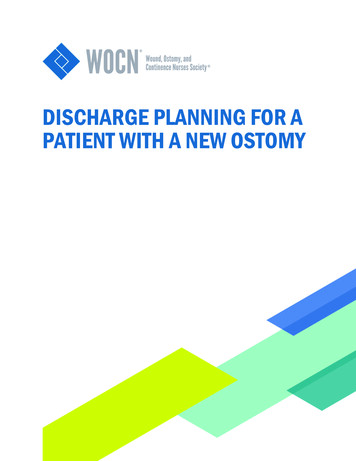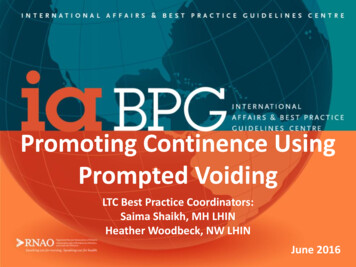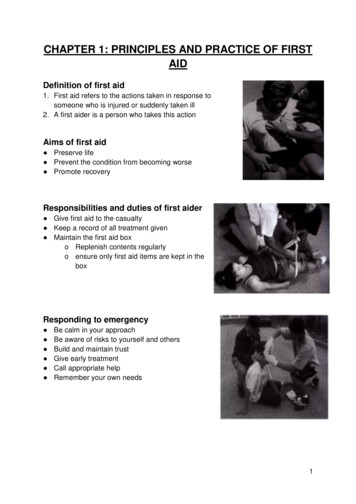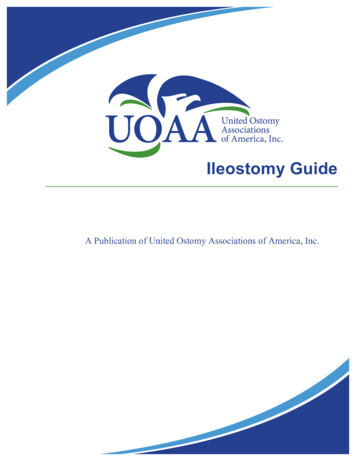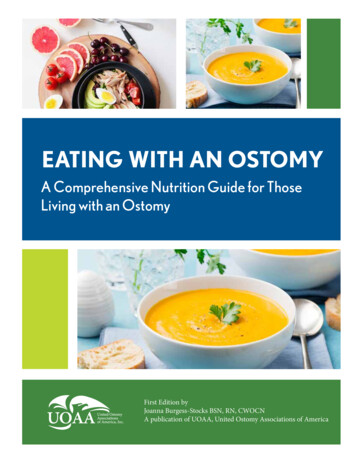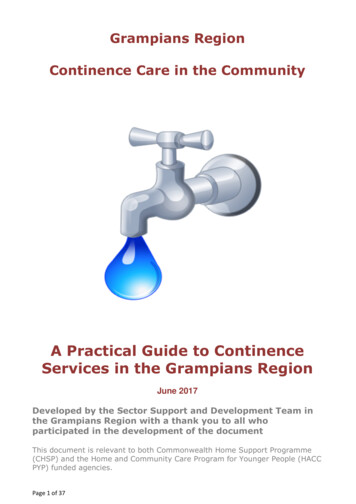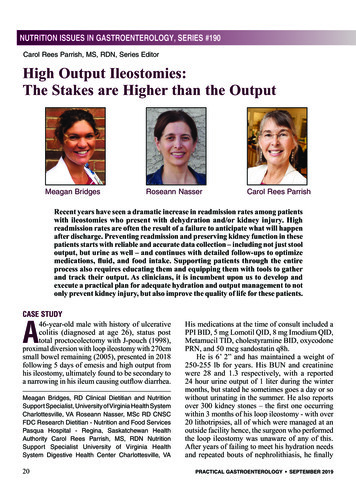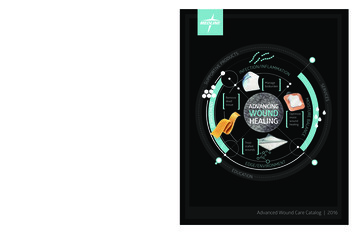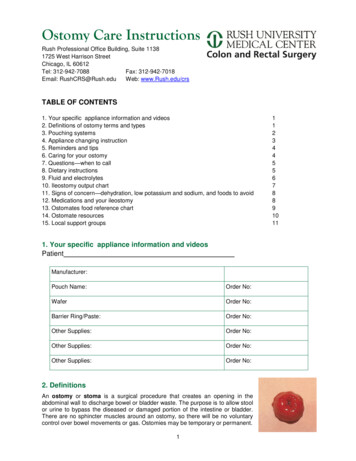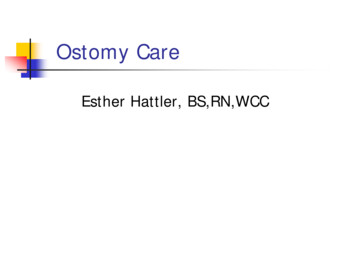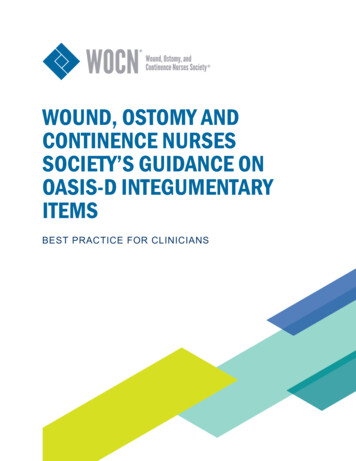
Transcription
WOUND, OSTOMY ANDCONTINENCE NURSESSOCIETY’S GUIDANCE ONOASIS-D INTEGUMENTARYITEMSBEST PRACTICE FOR CLINICIANS
Table of ContentsTable of Contents . 2Acknowledgments . 3Introduction . 4Purpose . 4Item Set. 4Pressure Injury Definition . 5Pressure Injury Classification System. 5Item Set Continued . 9Glossary . 10References . 12Acknowledgment about Content Validation . 13Wound, Ostomy and Continence Nurses SocietyTM (WOCN )2
AcknowledgmentsWound, Ostomy and Continence Nurses Society’s Guidance on OASIS-DIntegumentary Items: Best Practice for CliniciansThis document was developed by the WOCN Society’s OASIS TaskForce between November 2018 – December 2018.Task Force Chair:Barbara Dale, BSN, RN, CWOCN, CHHN, COS-C,Director of Wound CareQuality Home HealthLivingston, TennesseeTask Force Members:Dianne Mackey, MSN, RN,CWOCN Staff EducatorKaiser Permanente Home Health, Hospice and PalliativeCare San Diego, CaliforniaLaurie McNichol, MSN, RN, CNS, GNP, CWOCN, CWON-AP, FAANClinical Nurse Specialist/WOC NurseCone HealthGreensboro, North CarolinaBen Pierce, BA, RN, CWONVice President of Utilization and Quality ManagementWoundTechHollywood, FloridaThe Wound, Ostomy and Continence Nurses Society suggests the followingformat for bibliographic citations:Wound, Ostomy and Continence Nurses Society. (2019). Wound, Ostomy andContinence Nurses Society’s guidance on OASIS-D integumentary items: Bestpractice for clinicians. Mt. Laurel, NJ: Author.Copyright 2019 by the Wound, Ostomy and Continence Nurses Society. No part of thispublication may be reproduced, photocopied, or republished in any form, in whole or in part,without written permission of the Wound, Ostomy and Continence Nurses Society.Wound, Ostomy and Continence Nurses SocietyTM (WOCN )3
IntroductionOASIS-D, scheduled for implementation on January 1, 2019, is a modification to the Outcomeand Assessment Information Set (OASIS-C2) that Home Health Agencies must collect toparticipate in the Medicare program. OASIS-D includes modifications and new items tostandardize care across post-acute care (PAC) settings pursuant to the provisions of theIMPACT Act (Centers for Medicare & Medicaid Services [CMS], 2018a).Modifications in the OASIS-D integumentary status item set include removal of items: M1300 Pressure Ulcer Assessment M1302 Risk of Developing Pressure Ulcer M1313 Worsening of Pressure Ulcer Status M1320 Status of Most Problematic Pressure Ulcer M1350 Skin Lesion or Open WoundModifications to item text, intent or instructions were made to items (CMS, 2018b): M1306 Unhealed Pressure Ulcer/Injury at Stage 2 or Higher M1307 Oldest Stage 2 Pressure Ulcer M1311 Current Number of Pressure Ulcers/Injuries at Each Stage M1322 Current Number of Stage 1 Pressure Injuries M1324 Stage of Most Problematic Pressure Ulcer/Injury that is Stageable M1332 Current Number of Stasis Ulcer(s) that are Observable M1334 Status of Most Problematic Stasis Ulcer that is Observable M1340 Surgical WoundNote: The terms, definitions, and illustrations describing pressure ulcer/injury stages in thisdocument reflect the National Pressure Ulcer Advisory Panel’s (NPUAP) 2016 Pressure InjuryClassification System and related illustrations. “When discrepancies exist between theNPUAP definitions and the OASIS scoring instructions provided in the OASIS guidancemanual and CMS Q&A’s, providers should rely on the CMS OASIS instructions” (CMS,2018c).PurposeThe Wound, Ostomy and Continence Nurses Society (WOCN) developed the followingguidelines to facilitate the classification of wounds by home health clinicians. This guidancedocument was developed by consensus among a panel of WOCN Society content experts.The document updates a previous document: Wound, Ostomy and Continence NursesSociety’s Guidance on OASIS-C2 Integumentary Items: Best Practice for Clinicians (WOCN,2016). The original guidance document was developed in 2001 and has been previouslyupdated in 2006, 2009, and 2016.OASIS-D Integumentary Status (CMS, 2018d) Item Seto (M1306) Does this patient have at least one Unhealed PressureUlcer/Injury at Stage 2 or Higher or designated as Unstageable?(Excludes Stage 1 pressure injuries and all healed pressure ulcer/injuries)Wound, Ostomy and Continence Nurses SocietyTM (WOCN )4
Pressure Injury Definition (NPUAP, 2016)A pressure injury is localized damage to the skin and underlying soft tissue usually over a bonyprominence or related to a medical or other device. The injury can present as intact skin or anopen ulcer and may be painful. The injury occurs as a result of intense and/or prolongedpressure or pressure in combination with shear. The tolerance of soft tissue for pressure andshear may also be affected by microclimate, nutrition, perfusion, co-morbidities and condition ofthe soft tissue. Pressure Injury Classification System (NPUAP, 2016):Stage 1 Pressure Injury: Non-blanchable erythema of intact skinIntact skin with a localized area of non-blanchable erythema, which may appeardifferently in darkly pigmented skin. Presence of blanchable erythema or changes insensation, temperature, or firmness may precede visual changes. Color changes donot include purple or maroon discoloration; these may indicate deep tissue pressureinjury.Wound, Ostomy and Continence Nurses SocietyTM (WOCN )5
Stage 2 Pressure Injury: Partial-thickness skin loss with exposed dermisPartial-thickness loss of skin with exposed dermis. The wound bed is viable, pink orred, moist, and may also present as an intact or ruptured serum-filled blister. Adipose(fat) is not visible and deeper tissues are not visible. Granulation tissue, slough andeschar are not present. These injuries commonly result from adverse microclimate andshear in the skin over the pelvis and shear in the heel. This stage should not be used todescribe moisture associated skin damage (MASD) including incontinence associateddermatitis (IAD), intertriginous dermatitis (ITD), medical adhesive related skin injury(MARSI), or traumatic wounds (skin tears, burns, abrasions).Stage 3 Pressure Injury: Full-thickness skin lossFull-thickness loss of skin, in which adipose (fat) is visible in the ulcer and granulationtissue and epibole (rolled wound edges) are often present. Slough and/or eschar maybe visible. The depth of tissue damage varies by anatomical location; areas ofsignificant adiposity can develop deep wounds. Undermining and tunneling mayoccur. Fascia, muscle, tendon, ligament, cartilage and/or bone are not exposed. Ifslough or eschar obscures the extent of tissue loss this is an Unstageable PressureInjury.Wound, Ostomy and Continence Nurses SocietyTM (WOCN )6
Stage 4 Pressure Injury: Full-thickness skin and tissue lossFull-thickness skin and tissue loss with exposed or directly palpable fascia, muscle,tendon, ligament, cartilage or bone in the ulcer. Slough and/or eschar may bevisible. Epibole (rolled edges), undermining and/or tunneling often occur. Depthvaries by anatomical location. If slough or eschar obscures the extent of tissue lossthis is an Unstageable Pressure Injury.Unstageable Pressure Injury: Obscured full-thickness skin and tissue lossFull-thickness skin and tissue loss in which the extent of tissue damage within the ulcercannot be confirmed because it is obscured by slough or eschar. If slough or eschar isremoved, a Stage 3 or Stage 4 pressure injury will be revealed. Stable eschar (i.e. dry,adherent, intact without erythema or fluctuance) on the heel or ischemic limb shouldnot be softened or removed.Wound, Ostomy and Continence Nurses SocietyTM (WOCN )7
Deep Tissue Pressure Injury: Persistent non-blanchable deep red, maroonor purple discolorationIntact or non-intact skin with localized area of persistent non-blanchable deep red,maroon, purple discoloration or epidermal separation revealing a dark wound bed orblood filled blister. Pain and temperature change often precede skin color changes.Discoloration may appear differently in darkly pigmented skin. This injury results fromintense and/or prolonged pressure and shear forces at the bone-muscle interface. Thewound may evolve rapidly to reveal the actual extent of tissue injury, or may resolvewithout tissue loss. If necrotic tissue, subcutaneous tissue, granulation tissue, fascia,muscle or other underlying structures are visible, this indicates a full thicknesspressure injury (Unstageable, Stage 3 or Stage 4). Do not use DTPI to describevascular, traumatic, neuropathic, or dermatologic conditions.Additional pressure injury definitions.Medical Device Related Pressure Injury:This describes an etiology.Medical device related pressure injuries result from the use of devices designed andapplied for diagnostic or therapeutic purposes. The resultant pressure injury generallyconforms to the pattern or shape of the device. The injury should be staged using the stagingsystem.Wound, Ostomy and Continence Nurses SocietyTM (WOCN )8
Mucosal Membrane Pressure Injury: Mucosal membrane pressure injury is found on mucousmembranes with a history of a medical device in use at the location of the injury. Due to theanatomy of the tissue these ulcers cannot be staged. Item Set Continuedo (M1307) The Oldest Stage 2 Pressure Ulcer that is present at discharge.(Excludes healed Stage 2 pressure ulcers.)o (M1311) Current Number of Unhealed Pressure Ulcers/Injuries at Each Stage.o (M1322) Current Number of Stage 1 Pressure Injuries.o (M1324) Stage of Most Problematic Unhealed Pressure Ulcer/Injury that isStageable. (Excludes pressure ulcer/injury that cannot be staged due to a nonremovable dressing/device, coverage of wound bed by slough and/or eschar, ordeep tissue injury.)o (M1330) Does this patient have a Stasis Ulcer?o (M1332) Current Number of Stasis Ulcer(s) that are Observable.o (M1334) Status of Most Problematic Stasis Ulcer that is Observable.1 Fully granulating - Wound bed filled with granulation tissue to the level of thesurrounding skin; and – no dead space; and – no avascular tissue (escharand/or slough); and – no signs or symptoms of infection; and – wound edgesare open.2 Early/partial granulation – Wound bed covered with 25% of granulationtissue; and – wound bed covered with 25% of avascular tissue (escharand/or slough); and – no signs or symptoms of infection; and – wound edgesare open.3 Not healing – Wound with 25% avascular tissue (eschar and/or slough); or– signs/symptoms of infection; or – clean but nongranulating wound bed; or –closed/hyperkeratotic wound edges; or – persistent failure to improve despiteappropriate and comprehensive wound management.o (M1340) Does this patient have a Surgical Wound?o (M1342) Status of Most Problematic Surgical Wound that is Observable:0 Newly epithelialized – Wound bed completely covered with new epithelium; and– no exudate; and – no avascular tissue (eschar and/or slough); and – no signsor symptoms of infection.1 Fully granulating – Wound bed filled with granulation tissue to the level of thesurrounding skin; and – no dead space; and – no avascular tissue (escharand/or slough); and – no signs or symptoms of infection; and – wound edgesare open.2 Early/partial granulation – Wound bed is covered with 25% of granulationtissue; and – wound bed is covered with 25% of avascular tissue (escharand/or slough); and – no signs or symptoms of infection; and – wound edgesare open.3 Not healing – Wound with 25% avascular tissue (eschar and/or slough);or signs/symptoms of infection; or – clean but nongranulating wound bed; or– closed/hyperkeratotic wound edges; or – persistent failure to improvedespite appropriate and comprehensive wound management.Wound, Ostomy and Continence Nurses SocietyTM (WOCN )9
GlossaryAvascular. Lacking in blood supply; synonyms are dead, devitalized, necrotic, andnonviable.Specific types of avascular tissue include slough and eschar.Clean Wound. Wound is free of avascular tissue, purulent drainage, foreign material, or debris.Closed Wound Edges. Edges of the top layers of epidermis have rolled down to cover thelower edge of the epidermis, including the basement membrane, so that epithelial cells cannotmigrate from the wound edges. This condition is also known as epibole. It presentsclinically as a sealed edge of mature epithelium, which may be hardened, thickened,and discolored (e.g., yellowish, gray, or white).Dead Space. A defect or cavity in a wound.Epibole. See closed wound edges.Epidermis. The outermost layer of skin.Epithelialized. Regeneration of the epidermis across a wound surface.Eschar. Black or brown avascular tissue; tissue can be loose or firmly adherent, hard, softor soggy.Full Thickness. Tissue damage involving a total loss of the epidermis and dermis thatextends into the subcutaneous tissue and may expose muscle, bone, or underlyingstructures.Granulation Tissue. The pink/red, moist tissue comprised of new blood vessels, connectivetissue, fibroblasts, and inflammatory cells, which fills an open wound when it starts to heal;and typically appears deep pink or red with an irregular, “berry-like” surface.Healing. A dynamic process involving synthesis of new tissue for repair of skin and soft tissuedefects.Hyperkeratotic. Hard, white/gray tissue surrounding the wound resulting fromthickening/hypertrophy of the horny layer (stratum corneum) of the epidermis (FarlexPartner Medical Dictionary, 2012).Infection. The presence of bacteria or other microorganisms in sufficient quantity to damagetissue or impair healing. Infection has been defined as a bacterial bioburden of equal to orgreater than 105 colony forming units per gram of tissue or cm2 swab, and/or thepresence of Beta-hemolytic Streptococci (NPUAP et al., 2014; Weir & Schultz, 2016).Typical signs and symptoms of infection include purulent exudate, odor, erythema,warmth, tenderness, edema, pain, fever, and an elevated white blood cell count. However,clinical signs of infection may not be present, especially in the immunocompromisedpatient or the patient with poor perfusion.Necrotic Tissue. See avascular.Newly epithelialized. The process of regeneration of the epidermis across a wound surface orregeneration of the epidermis across a wound surface.Nonepithelialized. Absence of the regeneration of the epidermis across a woundsurface.Nongranulating. Absence of granulation tissue; the wound surface appears smooth asopposed to granular. For example, in a wound that is clean but nongranulating, thewound surface appears smooth and red as opposed to “berry-like”.Partial Thickness. Tissue damage confined to the skin layers; damage does not penetratebelow the dermis and may be limited to the epidermal layers only.Sinus Tract. A course or path of tissue destruction occurring in any direction from the surface oredge of the wound (also called “tunneling”), which results in dead space with a potential forabscess formation. It can be distinguished from undermining by the fact that a sinus tractWound, Ostomy and Continence Nurses SocietyTM (WOCN )10
involves a small portion of the wound edge; whereas, undermining involves a significantportion of the wound edge.Slough. Soft, moist, avascular tissue; may be white, yellow, tan, or green; and may be looseor firmly adherent.Stage 4 Structures. Anatomical structures, any of which when visible in a full-thicknesspressure ulcer, indicate the wound is reportable as a Stage 4 pressure ulcer. Stage4 structures include bone, muscle, tendon, and joint capsule.Tunneling. See sinus tract.Undermining. An area of tissue destruction extending under intact skin along the periphery of awound that is commonly seen in shear injuries. It can be distinguished from a sinus tract bythe fact that undermining involves a significant portion of the wound edge; whereas, a sinustract involves only a small portion of the wound edge.Unhealed. Absence of the skin’s original integrity.Wound, Ostomy and Continence Nurses SocietyTM (WOCN )11
ReferencesCenters for Medicare & Medicaid Services. (2018a). OASIS User Manuals: draftOASIS-D Guidance Manual. Retrieved November 17, 2018, fromhttps://www.cms.govCenters for Medicare & Medicaid Services. (2018b). OASIS-D guidance manual-effective1-1- 2019. Appendix G-4, G-5. Retrieved November 17, yInits/Downloads/draft-OASIS-D-Guidance-Manual-72- 2018.pdfCenters for Medicare & Medicaid Services. (2018c). OASIS-D guidance manual-effective1-1- 2019. Chapter 3: F-1. Retrieved November 17, yInits/Downloads/draft-OASIS-D-Guidance-Manual-72- 2018.pdfCenters for Medicare & Medicaid Services. (2018d). OASIS-D guidance manualeffective 1-1- 2019. Chapter 3: Section F- Integumentary. Retrieved November17, 2018, atientAssessment- -OASIS-DGuidance-Manual-7-2- 2018.pdfFarlex Partner Medical Dictionary. (2012). Hyperkeratotic. Retrieved April 3, 2016,from erkeratoticNational Pressure Ulcer Advisory Panel, European Pressure Ulcer Advisory Panel, &Pan Pacific Pressure Injury Alliance. (2014). Prevention and treatment ofpressure ulcers: Quick reference guide. Emily Haesler (Ed.). Osborne Park,Western Australia: Cambridge Media. Retrieved May 5, 2016, 8/Quick- fNational Pressure Ulcer Advisory Panel. (2016). NPUAP pressure injury stages.Retrieved December 12, 2018, from ical- resources/npuap-pressure-injury-stagesWeir, D., & Schultz, G. (2016). Assessment and management of wound-related infections. InD.B. Doughty & L. L. McNichol (Eds.), Wound, Ostomy and Continence Nurses Society corecurriculum: Wound management (pp.156–180). Philadelphia, PA: Wolters Kluwer.Wound, Ostomy and Continence Nurses Society. (2016). Wound, Ostomy andContinence Nurses Society’s guidance on OASIS-C2 integumentary items: Bestpractice for clinicians. Mt. Laurel, NJ: Author.Wound, Ostomy and Continence Nurses SocietyTM (WOCN )12
Acknowledgment about Content ValidationThis document was reviewed in the consensus-building process of the Wound, Ostomyand Continence Nurses Society known as Content Validation.Wound, Ostomy and Continence Nurses SocietyTM (WOCN )13
dermatitis (IAD), intertriginous dermatitis (ITD), medical adhesive related skin injury (MARSI), or traumatic wounds (skin tears, burns, abrasions). Stage 3 Pressure Injury: Full-thickness skin loss Full-thickness loss of skin, in which adipose (fat) is visible in the ulcer and granulation tissue and epibole

